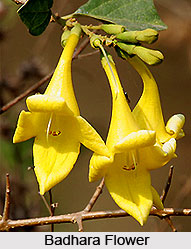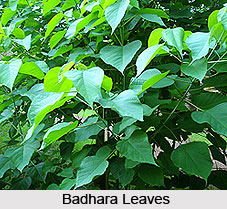 Badhara is a climbing shrub with yellowish-white bark which is found mainly in the scrub forests in India. Badhara is a fast-growing deciduous tree, occurring naturally throughout greater part of India at altitudes up to 1,500 meters. In India, Badhara occurs extensively from the eastwards in the sub-Himalayan tracts, common throughout Assam and adjoining areas of northern West Bengal, also in southern Bihar and Odisha, sporadically found in western and southern India and planted elsewhere on a large scale. Badhara most commonly occurs in West Bengal forests in mixed forests.
Badhara is a climbing shrub with yellowish-white bark which is found mainly in the scrub forests in India. Badhara is a fast-growing deciduous tree, occurring naturally throughout greater part of India at altitudes up to 1,500 meters. In India, Badhara occurs extensively from the eastwards in the sub-Himalayan tracts, common throughout Assam and adjoining areas of northern West Bengal, also in southern Bihar and Odisha, sporadically found in western and southern India and planted elsewhere on a large scale. Badhara most commonly occurs in West Bengal forests in mixed forests.
Different Names of Badhara
It botanical name is "Gmelina Asiatica L". There are various other names by which it is called in India are "Nag-phul" in Hindi, "Cherkumizhi" and "Kumilamaram" in Malayalam, "Gombhari", "Nondano" and "Gopogomb-hari" in Oriya, "Biddari", "Kasmari", "Vikarini" and "Gopabhadra" in Sanskrit, "Adavigummadi", "Chirugummudu", "Challagumudu", "Gummadi", "Chirunelli" and "Shirigumudu" in Telugu, "Lahan-shivan" in Marathi, "Gulada Mara", "Kalshivani", "Kumatha" and "Guludu" in Kannada, "Badhara" in Punjabi, "Kumalai", "Kumil", "Kadambal", "Kumizhaniaram", "Nilakkumil" and "Nilakkimnizh" in Tamil and "Bhadra" or "Gamari" in Bengali. Badhara belongs to the "Verbenaceae" family.
Characteristic Features of Badhara
 Badhara is a medium-sized deciduous tree. It is a large, spiny, straggling or sometimes climbing shrub with yellowish-white bark and rigid, horizontal branchlets, often shortened and spinous at the ends. The leaves of this shrub are highly variable, 1 to 9.5 cm long and 1.3 to 6 cm wide, ovate or elliptic, sometimes irregularly lobulate, lower surface coated with minute, round glands, apex acute or obtuse, base acute or rounded; petioles are 0.5 to 3 cm long. The flowers of Badhara are large, nodding, bright yellow, borne in terminal, densely pubescent racemes; calyx are 4 to 5 mm long, cup-shaped, pubescent, clothed with round, flattened glands, 4 lobes, minute, triangular; corolla is 2 lipped, 4.5 cm long, finely pubescent outside, tube narrow below, curved, inflated above, 4 lobes, ovate. The fruits of this Indian Medicinal Plant are ovoid or obovoid, 2 cm long, yellow when ripe and bear 1 or 2 seeds.
Badhara is a medium-sized deciduous tree. It is a large, spiny, straggling or sometimes climbing shrub with yellowish-white bark and rigid, horizontal branchlets, often shortened and spinous at the ends. The leaves of this shrub are highly variable, 1 to 9.5 cm long and 1.3 to 6 cm wide, ovate or elliptic, sometimes irregularly lobulate, lower surface coated with minute, round glands, apex acute or obtuse, base acute or rounded; petioles are 0.5 to 3 cm long. The flowers of Badhara are large, nodding, bright yellow, borne in terminal, densely pubescent racemes; calyx are 4 to 5 mm long, cup-shaped, pubescent, clothed with round, flattened glands, 4 lobes, minute, triangular; corolla is 2 lipped, 4.5 cm long, finely pubescent outside, tube narrow below, curved, inflated above, 4 lobes, ovate. The fruits of this Indian Medicinal Plant are ovoid or obovoid, 2 cm long, yellow when ripe and bear 1 or 2 seeds.
Medicinal Values of Badhara
In Ayurveda, it has been observed that Badhara fruit is acrid, sour, bitter, sweet, cooling, diuretic tonic, aphrodisiac, alternative astringent to the bowels, promote growth of hairs, useful in "vata", thirst, anaemia, leprosy, ulcers and vaginal discharge. The plant is recommended in combination with other drugs for the treatment of snakebite and scorpion sting. In snakebite a decoction of the root and bark is given internally.
The root is aromatic, mucilaginous, alterative, demulcent and astringent. It is used chiefly as a demulcent to treat catarrh of the bladder, but also in treating gonorrhoea, rheumatism and also acts as a blood purifier. In Unani medicine in India, the root is regarded as aphrodisiac and expectorant and is also used to give relief from joint pains. Among the tribal inhabitants of southern Andhra Pradesh, a paste of the roots mixed with cloves is used to relieve toothache. The leaves and young shoots of this medicinal plant contain thick, viscid, mucilage that is used to treat cough and relieve painful urination. In Siddha, the roots and mucilaginous leaves are used to treat digestive disorders, diarrhoea, leucorrhoea, cystitis and oliguria. The fruit is applied to the forehead to relieve burning sensations in the eyes and to cool the body. Flowers are astringent; useful in leprosy and blood diseases.



















